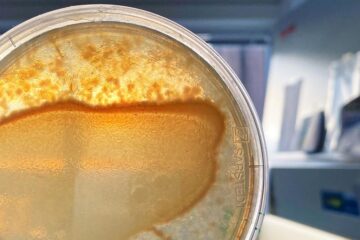RODental – Removable adhesion material for dental applications

RODental is a dentistry cement containing encapsulated phase-change material. This novel type of cement allows a removal of permanent and provisionally fixed dental restorations when needed (remove on demand) – without destroying or damaging these. Because properties of RODental can be triggered by temperature, all ceramic restorations, e. g. crowns, brackets or bridges on implants or teeth, can be mechanically removed in an easy way.
Challenge: Mainly there are three applications, for which new adhesive material is required: 1. Until today, dental cement used to cement fixed restorations on teeth or implants is optimized for permanent fixation. In case of clinical or technical complications, e. g. screw loosening on implants, parodontitis or ceramic chipping, a necessary removal of the restoration leads to destruction or damage. Re-use of the restoration is rarely possible, thus removing so far regularly requires a new preparation, combined with additional expenses. 2. In case of provisional fixation of long time provisional restorations stability over a certain period of time is a desirable feature. Cements currently available are not stable over time. Restorations may fall off at any time and may even be aspirated or swallowed by the patient. 3. To date orthodontic brackets have to be removed with special nippers and the adhesive cement remaining on the tooth structure has to be removed with diamond or hard metal burs. This procedure is time consuming. In addition it bears the risk of damaging the tooth structure.
Weitere Informationen: PDF
PROvendis GmbH
Tel.: +49 (0)208/94105 10
Ansprechpartner
Dipl.-Ing. Alfred Schillert
Media Contact
Alle Nachrichten aus der Kategorie: Technologieangebote
Neueste Beiträge

Das Mikrobiom verändert sich dynamisch und begünstigt wichtige Funktionen für den Wirt
Ein interdisziplinäres Forschungsteam des Kieler SFB 1182 untersucht am Beispiel von Fadenwürmern, welche Prozesse die Zusammensetzung des Mikrobioms in Wirtslebewesen steuern. Alle vielzelligen Lebewesen – von den einfachsten tierischen und…

Wasser im Boden – genaue Daten für Landwirtschaft und Klimaforschung
Die PTB präsentiert auf der Woche der Umwelt, wie sich die Bodenfeuchte mithilfe von Neutronenstrahlung messen lässt. Die Bodenfeuchte hat nicht nur Auswirkungen auf die Landwirtschaft, sondern ist als Teil…

Bioreaktor- und Kryotechnologien für bessere Wirkstofftests mit humanen Zellkulturen
Medizinische Wirkstoffforschung… Viele Neuentwicklungen von medizinischen Wirkstoffen scheitern, weil trotz erfolgreicher Labortests mit Zellkulturen starke Nebenwirkungen bei Probanden auftreten. Dies kann passieren, wenn zum Beispiel die verwendeten Zellen aus tierischem…

















